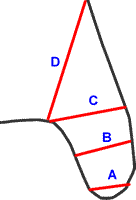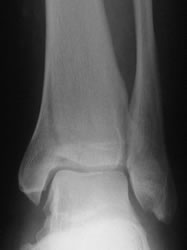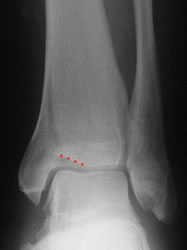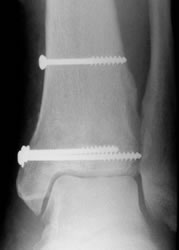
A - tip avulsions (anterior colliculus)
B - intermediate
C - level of plafond
D - above plafond (adduction fractures)

Think - could there be a missed proximal fibular or syndesmosis injury?
Fractures of the medial malleolus usually occur in association with fractures of the lateral and, less commonly, posterior malleolus. Issues around the management of such injuries are mainly dealt with in the pages on displaced ankle fractures.
The presence of a medial malleolar fracture is sometimes taken as an indication to operate on a displaced ankle fracture because of a perceived risk of symptomatic medial malleolar non-union. In fact this risk seems lower than is often thought. In the four randomised controlled trials of the management of displaced ankle fractures there were no symptomatic medial malleolar non-unions in about 300 patients treated with closed reduction and casting.
 |
| Herscovici classification of medial malleolar fractures. A - tip avulsions (anterior colliculus) B - intermediate C - level of plafond D - above plafond (adduction fractures) |
 |
Undisplaced medial malleolar fracture (Herscovici type C). Think - could there be a missed proximal fibular or syndesmosis injury? |
Isolated fractures of the medial malleolus do occur. Herscovici (2007) reported 67 isolated medial malleolar fractures, all treated in cast. All but two united, even in the presence of an average of 3mm displacement. Before deciding a medial fracture is isolated, look for an occult injury, especially to the proximal tibio-fibular joint, the proximal fibula or the syndesmotic ligaments, which would render the ankle complex unstable.
Herscovici produced a classification of medial malleolar fractures by level, drawing on previous classifications:
 |
 |
 |
| Adduction fracture of the medial malleolus. Note the adjacent plafond impaction (marked) | After reduction and bone grafting of the impacted joint surface and stabilisation with cancellous lag screws | |
Some medial malleolar fractures extend posteriorly into the posterior margin of the plafond. In Haraguchi's (2006) study of posterior marginal fractures, 20% involved the medial malleolus. Weber (2004) drew attention to these fractures, and to the need for more extensive exposure to allow reduction and stabilisation, often with a small posterior plate.